HI5017 Managerial Accounting: ABC Model Application in Qube Holding
VerifiedAdded on 2023/06/12
|13
|3180
|321
Report
AI Summary
This report delves into the application of Activity-Based Costing (ABC) within Qube Holding, an ASX-listed company, in the context of HI5017 Managerial Accounting. It highlights the shift from traditional costing methods to modern systems like ABC to improve cost allocation and decision-making. The report outlines the features of the ABC model, its implementation steps, and the benefits Qube Holding can derive from its use, including enhanced cost management, better decision-making, and strategic development. Alternative accounting tools like marginal and absorption costing are also discussed. The analysis underscores the potential of modern cost accounting systems in enhancing operational efficiency and profitability, recommending the installation of ABC models for better cost control and business expansion.
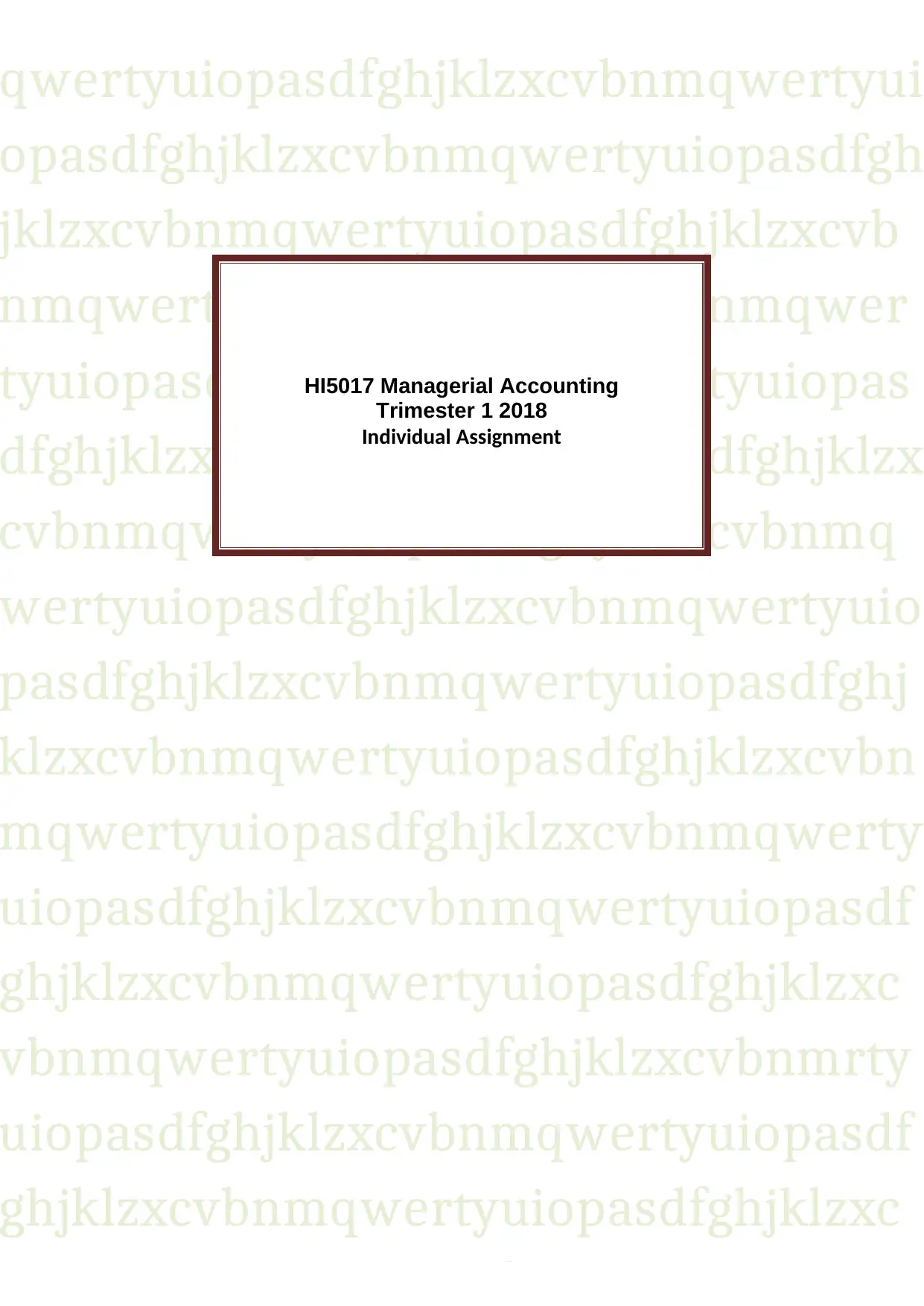
qwertyuiopasdfghjklzxcvbnmqwertyui
opasdfghjklzxcvbnmqwertyuiopasdfgh
jklzxcvbnmqwertyuiopasdfghjklzxcvb
nmqwertyuiopasdfghjklzxcvbnmqwer
tyuiopasdfghjklzxcvbnmqwertyuiopas
dfghjklzxcvbnmqwertyuiopasdfghjklzx
cvbnmqwertyuiopasdfghjklzxcvbnmq
wertyuiopasdfghjklzxcvbnmqwertyuio
pasdfghjklzxcvbnmqwertyuiopasdfghj
klzxcvbnmqwertyuiopasdfghjklzxcvbn
mqwertyuiopasdfghjklzxcvbnmqwerty
uiopasdfghjklzxcvbnmqwertyuiopasdf
ghjklzxcvbnmqwertyuiopasdfghjklzxc
vbnmqwertyuiopasdfghjklzxcvbnmrty
uiopasdfghjklzxcvbnmqwertyuiopasdf
ghjklzxcvbnmqwertyuiopasdfghjklzxc
vbnmqwertyuiopasdfghjklzxcvbnmqw
HI5017 Managerial Accounting
Trimester 1 2018
Individual Assignment
opasdfghjklzxcvbnmqwertyuiopasdfgh
jklzxcvbnmqwertyuiopasdfghjklzxcvb
nmqwertyuiopasdfghjklzxcvbnmqwer
tyuiopasdfghjklzxcvbnmqwertyuiopas
dfghjklzxcvbnmqwertyuiopasdfghjklzx
cvbnmqwertyuiopasdfghjklzxcvbnmq
wertyuiopasdfghjklzxcvbnmqwertyuio
pasdfghjklzxcvbnmqwertyuiopasdfghj
klzxcvbnmqwertyuiopasdfghjklzxcvbn
mqwertyuiopasdfghjklzxcvbnmqwerty
uiopasdfghjklzxcvbnmqwertyuiopasdf
ghjklzxcvbnmqwertyuiopasdfghjklzxc
vbnmqwertyuiopasdfghjklzxcvbnmrty
uiopasdfghjklzxcvbnmqwertyuiopasdf
ghjklzxcvbnmqwertyuiopasdfghjklzxc
vbnmqwertyuiopasdfghjklzxcvbnmqw
HI5017 Managerial Accounting
Trimester 1 2018
Individual Assignment
Paraphrase This Document
Need a fresh take? Get an instant paraphrase of this document with our AI Paraphraser
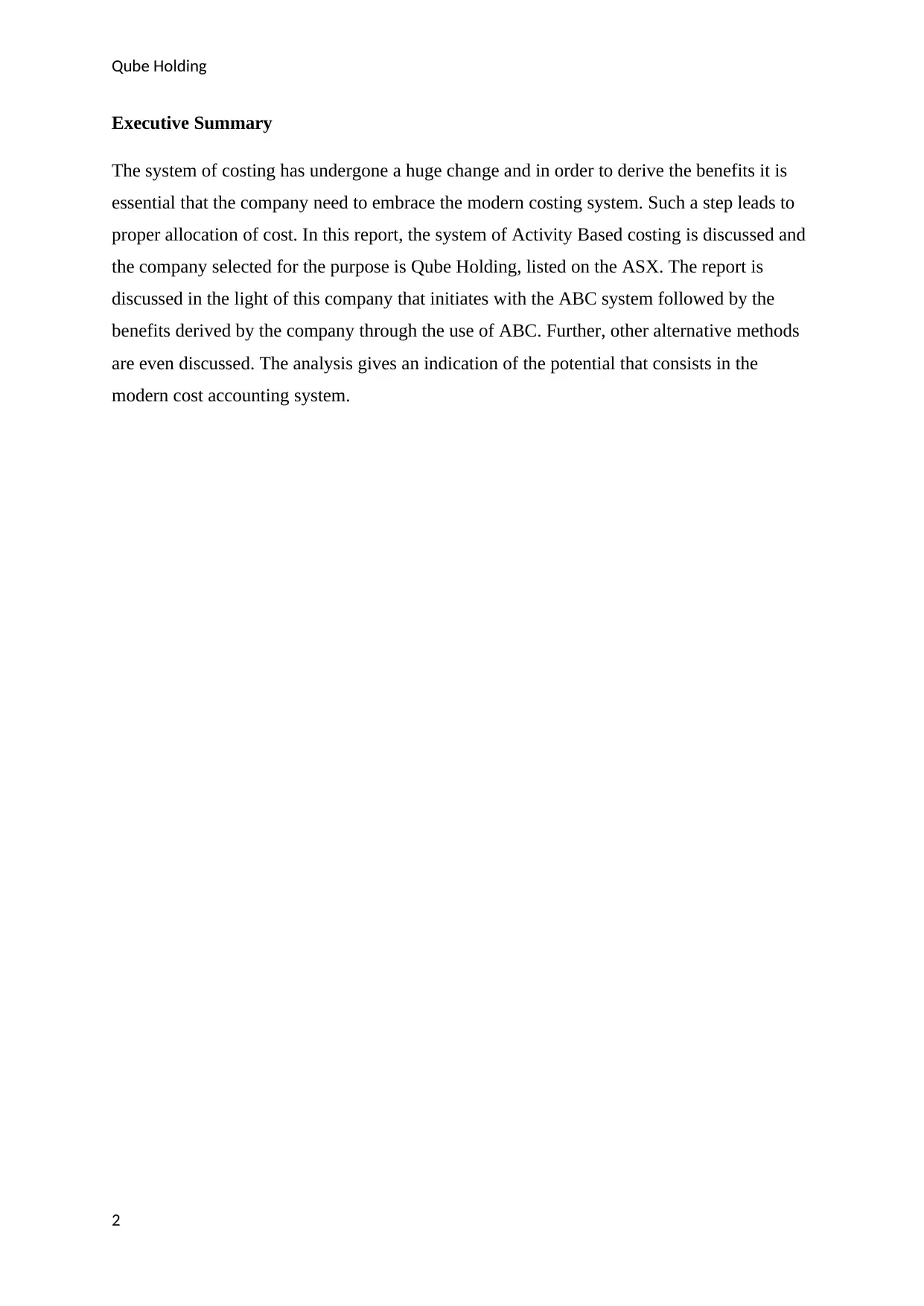
Qube Holding
Executive Summary
The system of costing has undergone a huge change and in order to derive the benefits it is
essential that the company need to embrace the modern costing system. Such a step leads to
proper allocation of cost. In this report, the system of Activity Based costing is discussed and
the company selected for the purpose is Qube Holding, listed on the ASX. The report is
discussed in the light of this company that initiates with the ABC system followed by the
benefits derived by the company through the use of ABC. Further, other alternative methods
are even discussed. The analysis gives an indication of the potential that consists in the
modern cost accounting system.
2
Executive Summary
The system of costing has undergone a huge change and in order to derive the benefits it is
essential that the company need to embrace the modern costing system. Such a step leads to
proper allocation of cost. In this report, the system of Activity Based costing is discussed and
the company selected for the purpose is Qube Holding, listed on the ASX. The report is
discussed in the light of this company that initiates with the ABC system followed by the
benefits derived by the company through the use of ABC. Further, other alternative methods
are even discussed. The analysis gives an indication of the potential that consists in the
modern cost accounting system.
2
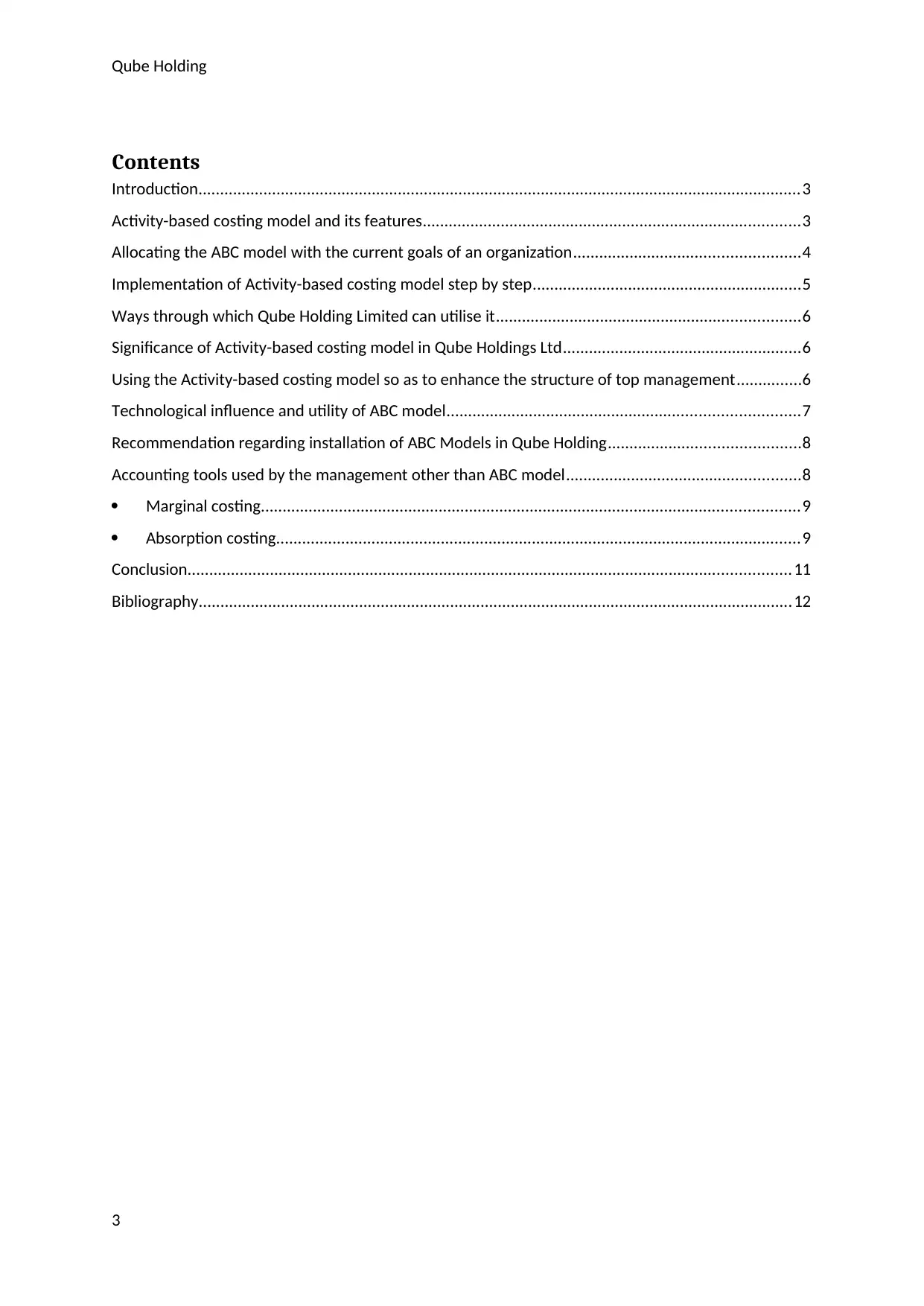
Qube Holding
Contents
Introduction...........................................................................................................................................3
Activity-based costing model and its features.......................................................................................3
Allocating the ABC model with the current goals of an organization....................................................4
Implementation of Activity-based costing model step by step..............................................................5
Ways through which Qube Holding Limited can utilise it......................................................................6
Significance of Activity-based costing model in Qube Holdings Ltd.......................................................6
Using the Activity-based costing model so as to enhance the structure of top management...............6
Technological influence and utility of ABC model.................................................................................7
Recommendation regarding installation of ABC Models in Qube Holding............................................8
Accounting tools used by the management other than ABC model......................................................8
Marginal costing............................................................................................................................9
Absorption costing.........................................................................................................................9
Conclusion...........................................................................................................................................11
Bibliography.........................................................................................................................................12
3
Contents
Introduction...........................................................................................................................................3
Activity-based costing model and its features.......................................................................................3
Allocating the ABC model with the current goals of an organization....................................................4
Implementation of Activity-based costing model step by step..............................................................5
Ways through which Qube Holding Limited can utilise it......................................................................6
Significance of Activity-based costing model in Qube Holdings Ltd.......................................................6
Using the Activity-based costing model so as to enhance the structure of top management...............6
Technological influence and utility of ABC model.................................................................................7
Recommendation regarding installation of ABC Models in Qube Holding............................................8
Accounting tools used by the management other than ABC model......................................................8
Marginal costing............................................................................................................................9
Absorption costing.........................................................................................................................9
Conclusion...........................................................................................................................................11
Bibliography.........................................................................................................................................12
3
⊘ This is a preview!⊘
Do you want full access?
Subscribe today to unlock all pages.

Trusted by 1+ million students worldwide

Qube Holding
Introduction
A huge portion of indirect costs was aligned to the manufactured goods in the traditional
accounting method which was later on observed that such costs are not utilised equally by all
the manufactured goods and therefore the ancient accounting approach was not able to
effectively evaluate and calculate the exact costs associated with the production of such
goods and related services. This also means that the decision taken based on the data
evaluated through such approach might be inappropriate. ABC model is employed so as to
ascertain the total costs assigned to the production of a particular product line and related
services. ABC model not only helps in the identification of evaluation of costs associated
with every activity but also finds out the extent of such activities utilised by particular goods
and services. Therefore, the activities that employs high overhead costs are ascertained which
further helps the management in finding measures for reducing such unnecessary overhead
costs
Activity-based costing model and its features
Unlike the traditional costing approach where the allocation of costs was simply on the
machine hours, Activity based costing model distributes manufacturing overhead costs to
goods in a more systematic and appropriate manner. The activities that are the ultimate cause
of the overhead are first assigned costs through ABC model. Later the products that are
actually demanding the activities are assigned the cost of these activities1.
ABC model forms and facilitates a very casual relationship between the cost drivers and
indirect costs unlike traditional cost price systems. A transparent and cost-conscious conduct
is initiated by passing on this insight to the responsible cost drivers. The installation of ABC
model makes it easier for the company’s top management and personnel to have an
understanding of the different cost categories and determining activities that adds value to the
goodwill of the company. It also helps in evaluating and eliminating such activities that
depleted the value of the organization. This way Qube Holdings Limited can look for the
1 Petty, J. W, Titman, S., Keown, A. J., Martin, J. D., Burrow, M. and Nguyen, H. (2012)
Financial Management: Principles and Applications, 6th ed. Australia: Pearson Education
Australia.
4
Introduction
A huge portion of indirect costs was aligned to the manufactured goods in the traditional
accounting method which was later on observed that such costs are not utilised equally by all
the manufactured goods and therefore the ancient accounting approach was not able to
effectively evaluate and calculate the exact costs associated with the production of such
goods and related services. This also means that the decision taken based on the data
evaluated through such approach might be inappropriate. ABC model is employed so as to
ascertain the total costs assigned to the production of a particular product line and related
services. ABC model not only helps in the identification of evaluation of costs associated
with every activity but also finds out the extent of such activities utilised by particular goods
and services. Therefore, the activities that employs high overhead costs are ascertained which
further helps the management in finding measures for reducing such unnecessary overhead
costs
Activity-based costing model and its features
Unlike the traditional costing approach where the allocation of costs was simply on the
machine hours, Activity based costing model distributes manufacturing overhead costs to
goods in a more systematic and appropriate manner. The activities that are the ultimate cause
of the overhead are first assigned costs through ABC model. Later the products that are
actually demanding the activities are assigned the cost of these activities1.
ABC model forms and facilitates a very casual relationship between the cost drivers and
indirect costs unlike traditional cost price systems. A transparent and cost-conscious conduct
is initiated by passing on this insight to the responsible cost drivers. The installation of ABC
model makes it easier for the company’s top management and personnel to have an
understanding of the different cost categories and determining activities that adds value to the
goodwill of the company. It also helps in evaluating and eliminating such activities that
depleted the value of the organization. This way Qube Holdings Limited can look for the
1 Petty, J. W, Titman, S., Keown, A. J., Martin, J. D., Burrow, M. and Nguyen, H. (2012)
Financial Management: Principles and Applications, 6th ed. Australia: Pearson Education
Australia.
4
Paraphrase This Document
Need a fresh take? Get an instant paraphrase of this document with our AI Paraphraser

Qube Holding
improvements in the organization and yield positive rewards. ABC model also sets forth
decision making processes and account for strategic developments.
Allocating the ABC model with the current goals of an organization
ABC classifies costs and apportions them into respective heads rather than accumulating all
of them into one head. This simplifies the identification of costs apportioned to every activity.
Cost allocation, fixed costs, variable cost, cost driver and cost driver rate are the various
methodologies under ABC model2.
2 Petty, J. W, Titman, S., Keown, A. J., Martin, J. D., Burrow, M. and Nguyen, H. (2012)
Financial Management: Principles and Applications, 6th ed. Australia: Pearson Education
Australia.
5
improvements in the organization and yield positive rewards. ABC model also sets forth
decision making processes and account for strategic developments.
Allocating the ABC model with the current goals of an organization
ABC classifies costs and apportions them into respective heads rather than accumulating all
of them into one head. This simplifies the identification of costs apportioned to every activity.
Cost allocation, fixed costs, variable cost, cost driver and cost driver rate are the various
methodologies under ABC model2.
2 Petty, J. W, Titman, S., Keown, A. J., Martin, J. D., Burrow, M. and Nguyen, H. (2012)
Financial Management: Principles and Applications, 6th ed. Australia: Pearson Education
Australia.
5

Qube Holding
Implementation of Activity-based costing model step by step
- Research on processes and costs
- Identify activities and activity pools
- Identification of traceable costs
- Assigning left over costs to activities
- Determining per-activity allocation rates
- Apply costs to objects
- Preparation of management reports
It is easy to trace direct costs apportioned to the manufacturing of certain goods as compared
to indirect costs which are too complicated for there is variety of goods taking in use the
same inputs. The shared activity of different goods utilising the same resources is termed as
cost driver. The ultimate agenda behind implementation of ABC model is to develop and
increase the accuracy and efficiency of cost measurement to a huge extent by means of
reclassification of the maximum of its indirect costs as direct costs3.
The cost drivers are apportioned and aligned to the incurred costs by means of ABC model as
it is the basis of cost price calculation. It is always considered that the products and the
accompanying costs are casually related to one other4. For organizations having strategic
failures and downfall in the graph of corporate results, Activity based costing model acts as a
saviour for it helps in evaluating the unnecessary costs apportioned to activities and formulate
decision making and activities for cost reduction. This will further help such organizations in
garnering operational efficiency5. ABC model also helps in establishing the foundation for
Balanced Scorecard approach in a corporate.
3 Qube Holding Ltd. (2016) Qube Holding Ltd Annual report & accounts 2017 [online].
Available from: http://www.annualreports.com/Company/qube-holdings-ltd [Accessed 23
May 2018]
4 Phua, Y. S., M. A. Abernethy, and A. M. Lillis. (2011) Controls as exit barriers in
multiperiod outsourcing arrangements. The Accounting Review. [online]. 86, p. 1795–1834.
[Accessed 22 May 2018]
5 Parrino, R, Kidwell, D. & Bates, T. (2012). Fundamentals of corporate finance. Hoboken,
6
Implementation of Activity-based costing model step by step
- Research on processes and costs
- Identify activities and activity pools
- Identification of traceable costs
- Assigning left over costs to activities
- Determining per-activity allocation rates
- Apply costs to objects
- Preparation of management reports
It is easy to trace direct costs apportioned to the manufacturing of certain goods as compared
to indirect costs which are too complicated for there is variety of goods taking in use the
same inputs. The shared activity of different goods utilising the same resources is termed as
cost driver. The ultimate agenda behind implementation of ABC model is to develop and
increase the accuracy and efficiency of cost measurement to a huge extent by means of
reclassification of the maximum of its indirect costs as direct costs3.
The cost drivers are apportioned and aligned to the incurred costs by means of ABC model as
it is the basis of cost price calculation. It is always considered that the products and the
accompanying costs are casually related to one other4. For organizations having strategic
failures and downfall in the graph of corporate results, Activity based costing model acts as a
saviour for it helps in evaluating the unnecessary costs apportioned to activities and formulate
decision making and activities for cost reduction. This will further help such organizations in
garnering operational efficiency5. ABC model also helps in establishing the foundation for
Balanced Scorecard approach in a corporate.
3 Qube Holding Ltd. (2016) Qube Holding Ltd Annual report & accounts 2017 [online].
Available from: http://www.annualreports.com/Company/qube-holdings-ltd [Accessed 23
May 2018]
4 Phua, Y. S., M. A. Abernethy, and A. M. Lillis. (2011) Controls as exit barriers in
multiperiod outsourcing arrangements. The Accounting Review. [online]. 86, p. 1795–1834.
[Accessed 22 May 2018]
5 Parrino, R, Kidwell, D. & Bates, T. (2012). Fundamentals of corporate finance. Hoboken,
6
⊘ This is a preview!⊘
Do you want full access?
Subscribe today to unlock all pages.

Trusted by 1+ million students worldwide
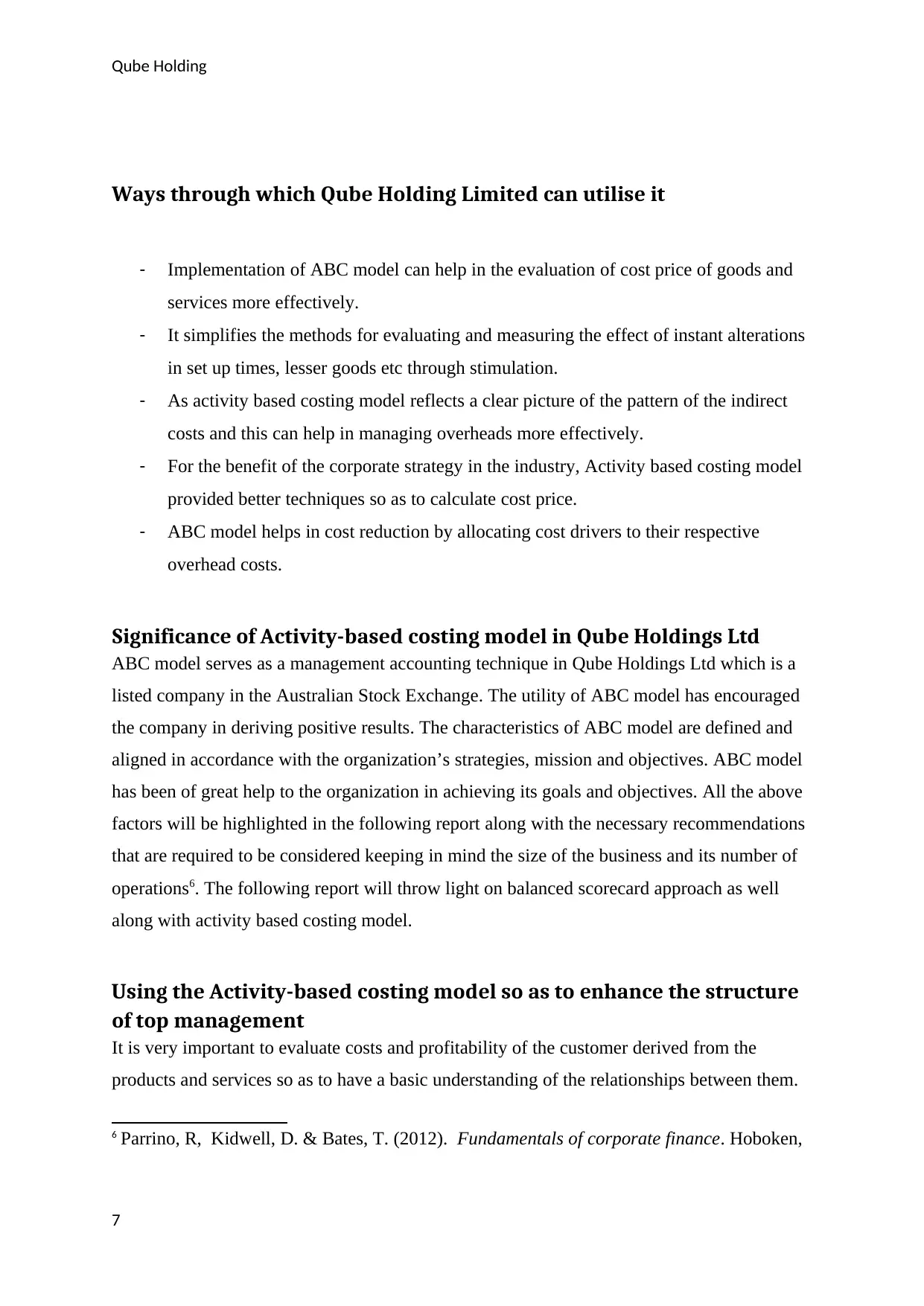
Qube Holding
Ways through which Qube Holding Limited can utilise it
- Implementation of ABC model can help in the evaluation of cost price of goods and
services more effectively.
- It simplifies the methods for evaluating and measuring the effect of instant alterations
in set up times, lesser goods etc through stimulation.
- As activity based costing model reflects a clear picture of the pattern of the indirect
costs and this can help in managing overheads more effectively.
- For the benefit of the corporate strategy in the industry, Activity based costing model
provided better techniques so as to calculate cost price.
- ABC model helps in cost reduction by allocating cost drivers to their respective
overhead costs.
Significance of Activity-based costing model in Qube Holdings Ltd
ABC model serves as a management accounting technique in Qube Holdings Ltd which is a
listed company in the Australian Stock Exchange. The utility of ABC model has encouraged
the company in deriving positive results. The characteristics of ABC model are defined and
aligned in accordance with the organization’s strategies, mission and objectives. ABC model
has been of great help to the organization in achieving its goals and objectives. All the above
factors will be highlighted in the following report along with the necessary recommendations
that are required to be considered keeping in mind the size of the business and its number of
operations6. The following report will throw light on balanced scorecard approach as well
along with activity based costing model.
Using the Activity-based costing model so as to enhance the structure
of top management
It is very important to evaluate costs and profitability of the customer derived from the
products and services so as to have a basic understanding of the relationships between them.
6 Parrino, R, Kidwell, D. & Bates, T. (2012). Fundamentals of corporate finance. Hoboken,
7
Ways through which Qube Holding Limited can utilise it
- Implementation of ABC model can help in the evaluation of cost price of goods and
services more effectively.
- It simplifies the methods for evaluating and measuring the effect of instant alterations
in set up times, lesser goods etc through stimulation.
- As activity based costing model reflects a clear picture of the pattern of the indirect
costs and this can help in managing overheads more effectively.
- For the benefit of the corporate strategy in the industry, Activity based costing model
provided better techniques so as to calculate cost price.
- ABC model helps in cost reduction by allocating cost drivers to their respective
overhead costs.
Significance of Activity-based costing model in Qube Holdings Ltd
ABC model serves as a management accounting technique in Qube Holdings Ltd which is a
listed company in the Australian Stock Exchange. The utility of ABC model has encouraged
the company in deriving positive results. The characteristics of ABC model are defined and
aligned in accordance with the organization’s strategies, mission and objectives. ABC model
has been of great help to the organization in achieving its goals and objectives. All the above
factors will be highlighted in the following report along with the necessary recommendations
that are required to be considered keeping in mind the size of the business and its number of
operations6. The following report will throw light on balanced scorecard approach as well
along with activity based costing model.
Using the Activity-based costing model so as to enhance the structure
of top management
It is very important to evaluate costs and profitability of the customer derived from the
products and services so as to have a basic understanding of the relationships between them.
6 Parrino, R, Kidwell, D. & Bates, T. (2012). Fundamentals of corporate finance. Hoboken,
7
Paraphrase This Document
Need a fresh take? Get an instant paraphrase of this document with our AI Paraphraser
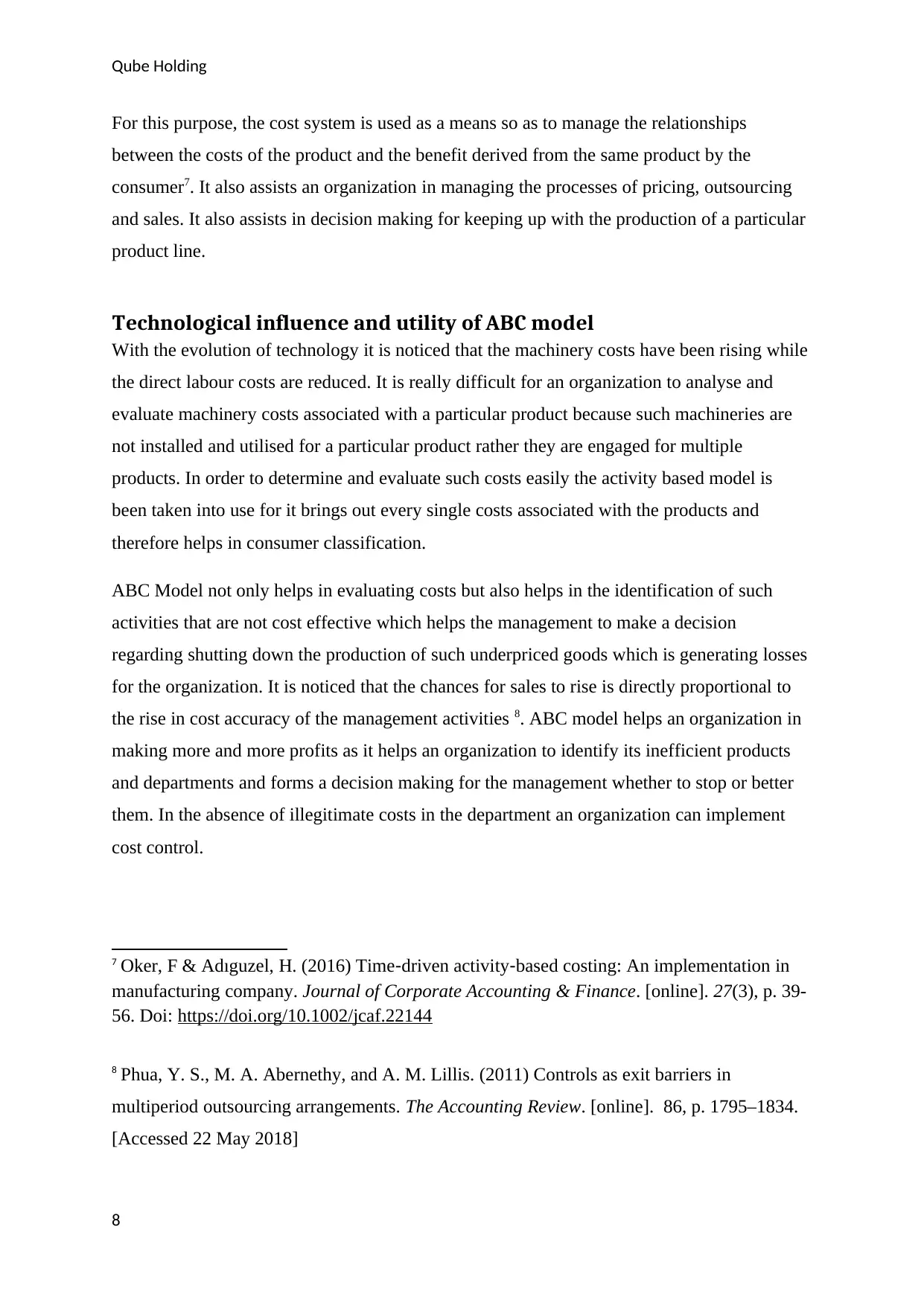
Qube Holding
For this purpose, the cost system is used as a means so as to manage the relationships
between the costs of the product and the benefit derived from the same product by the
consumer7. It also assists an organization in managing the processes of pricing, outsourcing
and sales. It also assists in decision making for keeping up with the production of a particular
product line.
Technological influence and utility of ABC model
With the evolution of technology it is noticed that the machinery costs have been rising while
the direct labour costs are reduced. It is really difficult for an organization to analyse and
evaluate machinery costs associated with a particular product because such machineries are
not installed and utilised for a particular product rather they are engaged for multiple
products. In order to determine and evaluate such costs easily the activity based model is
been taken into use for it brings out every single costs associated with the products and
therefore helps in consumer classification.
ABC Model not only helps in evaluating costs but also helps in the identification of such
activities that are not cost effective which helps the management to make a decision
regarding shutting down the production of such underpriced goods which is generating losses
for the organization. It is noticed that the chances for sales to rise is directly proportional to
the rise in cost accuracy of the management activities 8. ABC model helps an organization in
making more and more profits as it helps an organization to identify its inefficient products
and departments and forms a decision making for the management whether to stop or better
them. In the absence of illegitimate costs in the department an organization can implement
cost control.
7 Oker, F & Adıguzel, H. (2016) Time‐driven activity‐based costing: An implementation in
manufacturing company. Journal of Corporate Accounting & Finance. [online]. 27(3), p. 39-
56. Doi: https://doi.org/10.1002/jcaf.22144
8 Phua, Y. S., M. A. Abernethy, and A. M. Lillis. (2011) Controls as exit barriers in
multiperiod outsourcing arrangements. The Accounting Review. [online]. 86, p. 1795–1834.
[Accessed 22 May 2018]
8
For this purpose, the cost system is used as a means so as to manage the relationships
between the costs of the product and the benefit derived from the same product by the
consumer7. It also assists an organization in managing the processes of pricing, outsourcing
and sales. It also assists in decision making for keeping up with the production of a particular
product line.
Technological influence and utility of ABC model
With the evolution of technology it is noticed that the machinery costs have been rising while
the direct labour costs are reduced. It is really difficult for an organization to analyse and
evaluate machinery costs associated with a particular product because such machineries are
not installed and utilised for a particular product rather they are engaged for multiple
products. In order to determine and evaluate such costs easily the activity based model is
been taken into use for it brings out every single costs associated with the products and
therefore helps in consumer classification.
ABC Model not only helps in evaluating costs but also helps in the identification of such
activities that are not cost effective which helps the management to make a decision
regarding shutting down the production of such underpriced goods which is generating losses
for the organization. It is noticed that the chances for sales to rise is directly proportional to
the rise in cost accuracy of the management activities 8. ABC model helps an organization in
making more and more profits as it helps an organization to identify its inefficient products
and departments and forms a decision making for the management whether to stop or better
them. In the absence of illegitimate costs in the department an organization can implement
cost control.
7 Oker, F & Adıguzel, H. (2016) Time‐driven activity‐based costing: An implementation in
manufacturing company. Journal of Corporate Accounting & Finance. [online]. 27(3), p. 39-
56. Doi: https://doi.org/10.1002/jcaf.22144
8 Phua, Y. S., M. A. Abernethy, and A. M. Lillis. (2011) Controls as exit barriers in
multiperiod outsourcing arrangements. The Accounting Review. [online]. 86, p. 1795–1834.
[Accessed 22 May 2018]
8
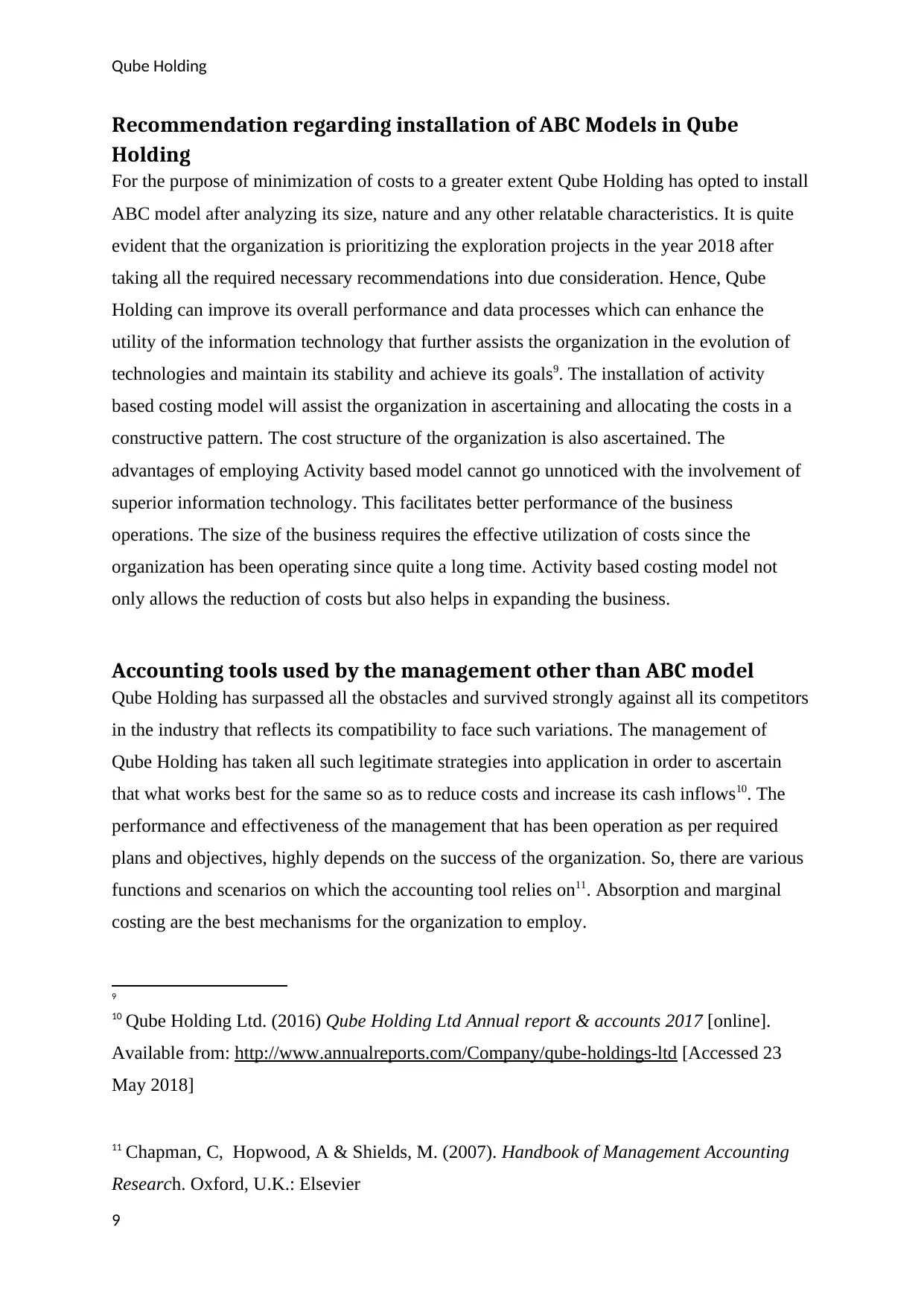
Qube Holding
Recommendation regarding installation of ABC Models in Qube
Holding
For the purpose of minimization of costs to a greater extent Qube Holding has opted to install
ABC model after analyzing its size, nature and any other relatable characteristics. It is quite
evident that the organization is prioritizing the exploration projects in the year 2018 after
taking all the required necessary recommendations into due consideration. Hence, Qube
Holding can improve its overall performance and data processes which can enhance the
utility of the information technology that further assists the organization in the evolution of
technologies and maintain its stability and achieve its goals9. The installation of activity
based costing model will assist the organization in ascertaining and allocating the costs in a
constructive pattern. The cost structure of the organization is also ascertained. The
advantages of employing Activity based model cannot go unnoticed with the involvement of
superior information technology. This facilitates better performance of the business
operations. The size of the business requires the effective utilization of costs since the
organization has been operating since quite a long time. Activity based costing model not
only allows the reduction of costs but also helps in expanding the business.
Accounting tools used by the management other than ABC model
Qube Holding has surpassed all the obstacles and survived strongly against all its competitors
in the industry that reflects its compatibility to face such variations. The management of
Qube Holding has taken all such legitimate strategies into application in order to ascertain
that what works best for the same so as to reduce costs and increase its cash inflows10. The
performance and effectiveness of the management that has been operation as per required
plans and objectives, highly depends on the success of the organization. So, there are various
functions and scenarios on which the accounting tool relies on11. Absorption and marginal
costing are the best mechanisms for the organization to employ.
9
10 Qube Holding Ltd. (2016) Qube Holding Ltd Annual report & accounts 2017 [online].
Available from: http://www.annualreports.com/Company/qube-holdings-ltd [Accessed 23
May 2018]
11 Chapman, C, Hopwood, A & Shields, M. (2007). Handbook of Management Accounting
Research. Oxford, U.K.: Elsevier
9
Recommendation regarding installation of ABC Models in Qube
Holding
For the purpose of minimization of costs to a greater extent Qube Holding has opted to install
ABC model after analyzing its size, nature and any other relatable characteristics. It is quite
evident that the organization is prioritizing the exploration projects in the year 2018 after
taking all the required necessary recommendations into due consideration. Hence, Qube
Holding can improve its overall performance and data processes which can enhance the
utility of the information technology that further assists the organization in the evolution of
technologies and maintain its stability and achieve its goals9. The installation of activity
based costing model will assist the organization in ascertaining and allocating the costs in a
constructive pattern. The cost structure of the organization is also ascertained. The
advantages of employing Activity based model cannot go unnoticed with the involvement of
superior information technology. This facilitates better performance of the business
operations. The size of the business requires the effective utilization of costs since the
organization has been operating since quite a long time. Activity based costing model not
only allows the reduction of costs but also helps in expanding the business.
Accounting tools used by the management other than ABC model
Qube Holding has surpassed all the obstacles and survived strongly against all its competitors
in the industry that reflects its compatibility to face such variations. The management of
Qube Holding has taken all such legitimate strategies into application in order to ascertain
that what works best for the same so as to reduce costs and increase its cash inflows10. The
performance and effectiveness of the management that has been operation as per required
plans and objectives, highly depends on the success of the organization. So, there are various
functions and scenarios on which the accounting tool relies on11. Absorption and marginal
costing are the best mechanisms for the organization to employ.
9
10 Qube Holding Ltd. (2016) Qube Holding Ltd Annual report & accounts 2017 [online].
Available from: http://www.annualreports.com/Company/qube-holdings-ltd [Accessed 23
May 2018]
11 Chapman, C, Hopwood, A & Shields, M. (2007). Handbook of Management Accounting
Research. Oxford, U.K.: Elsevier
9
⊘ This is a preview!⊘
Do you want full access?
Subscribe today to unlock all pages.

Trusted by 1+ million students worldwide
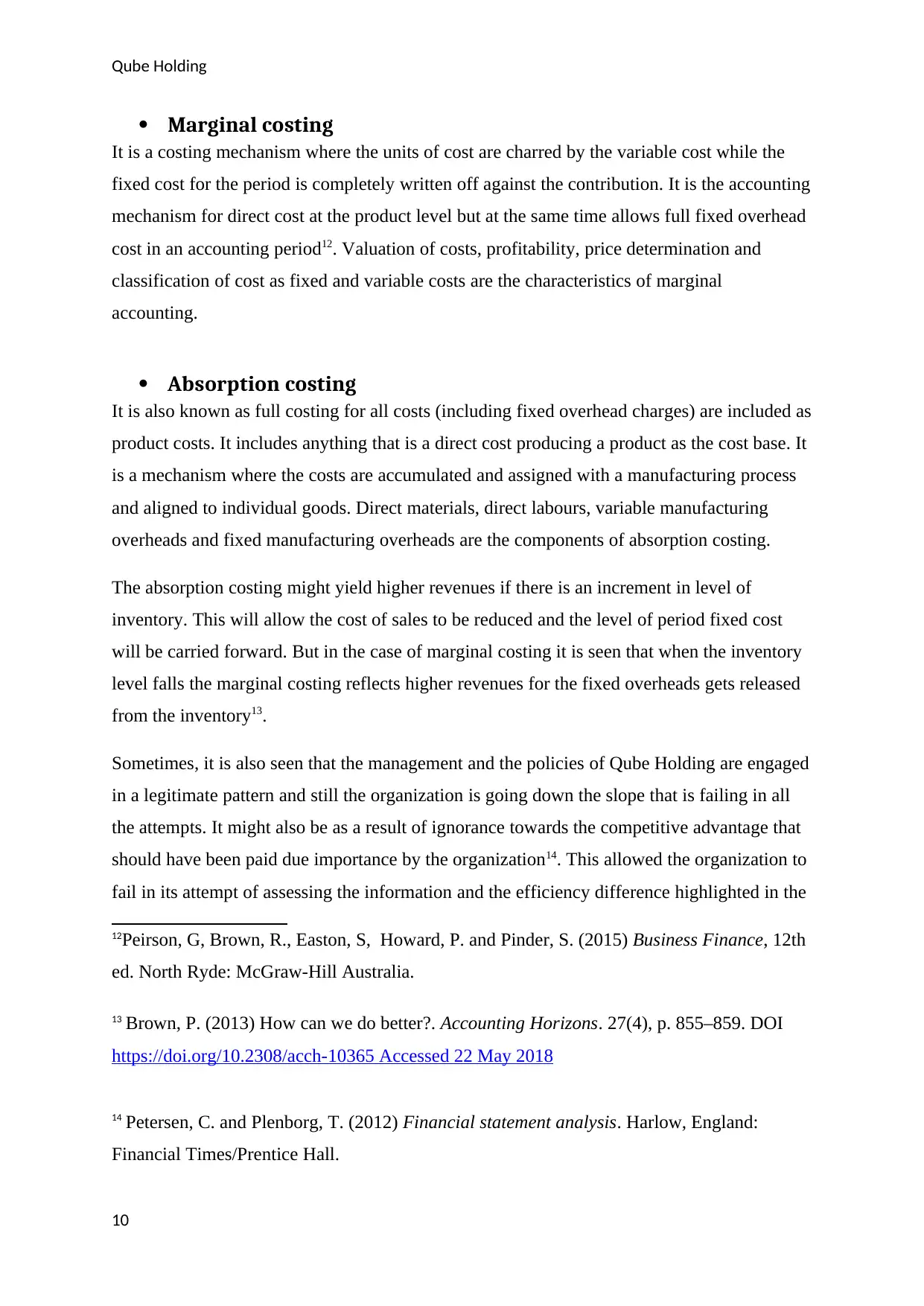
Qube Holding
Marginal costing
It is a costing mechanism where the units of cost are charred by the variable cost while the
fixed cost for the period is completely written off against the contribution. It is the accounting
mechanism for direct cost at the product level but at the same time allows full fixed overhead
cost in an accounting period12. Valuation of costs, profitability, price determination and
classification of cost as fixed and variable costs are the characteristics of marginal
accounting.
Absorption costing
It is also known as full costing for all costs (including fixed overhead charges) are included as
product costs. It includes anything that is a direct cost producing a product as the cost base. It
is a mechanism where the costs are accumulated and assigned with a manufacturing process
and aligned to individual goods. Direct materials, direct labours, variable manufacturing
overheads and fixed manufacturing overheads are the components of absorption costing.
The absorption costing might yield higher revenues if there is an increment in level of
inventory. This will allow the cost of sales to be reduced and the level of period fixed cost
will be carried forward. But in the case of marginal costing it is seen that when the inventory
level falls the marginal costing reflects higher revenues for the fixed overheads gets released
from the inventory13.
Sometimes, it is also seen that the management and the policies of Qube Holding are engaged
in a legitimate pattern and still the organization is going down the slope that is failing in all
the attempts. It might also be as a result of ignorance towards the competitive advantage that
should have been paid due importance by the organization14. This allowed the organization to
fail in its attempt of assessing the information and the efficiency difference highlighted in the
12Peirson, G, Brown, R., Easton, S, Howard, P. and Pinder, S. (2015) Business Finance, 12th
ed. North Ryde: McGraw-Hill Australia.
13 Brown, P. (2013) How can we do better?. Accounting Horizons. 27(4), p. 855–859. DOI
https://doi.org/10.2308/acch-10365 Accessed 22 May 2018
14 Petersen, C. and Plenborg, T. (2012) Financial statement analysis. Harlow, England:
Financial Times/Prentice Hall.
10
Marginal costing
It is a costing mechanism where the units of cost are charred by the variable cost while the
fixed cost for the period is completely written off against the contribution. It is the accounting
mechanism for direct cost at the product level but at the same time allows full fixed overhead
cost in an accounting period12. Valuation of costs, profitability, price determination and
classification of cost as fixed and variable costs are the characteristics of marginal
accounting.
Absorption costing
It is also known as full costing for all costs (including fixed overhead charges) are included as
product costs. It includes anything that is a direct cost producing a product as the cost base. It
is a mechanism where the costs are accumulated and assigned with a manufacturing process
and aligned to individual goods. Direct materials, direct labours, variable manufacturing
overheads and fixed manufacturing overheads are the components of absorption costing.
The absorption costing might yield higher revenues if there is an increment in level of
inventory. This will allow the cost of sales to be reduced and the level of period fixed cost
will be carried forward. But in the case of marginal costing it is seen that when the inventory
level falls the marginal costing reflects higher revenues for the fixed overheads gets released
from the inventory13.
Sometimes, it is also seen that the management and the policies of Qube Holding are engaged
in a legitimate pattern and still the organization is going down the slope that is failing in all
the attempts. It might also be as a result of ignorance towards the competitive advantage that
should have been paid due importance by the organization14. This allowed the organization to
fail in its attempt of assessing the information and the efficiency difference highlighted in the
12Peirson, G, Brown, R., Easton, S, Howard, P. and Pinder, S. (2015) Business Finance, 12th
ed. North Ryde: McGraw-Hill Australia.
13 Brown, P. (2013) How can we do better?. Accounting Horizons. 27(4), p. 855–859. DOI
https://doi.org/10.2308/acch-10365 Accessed 22 May 2018
14 Petersen, C. and Plenborg, T. (2012) Financial statement analysis. Harlow, England:
Financial Times/Prentice Hall.
10
Paraphrase This Document
Need a fresh take? Get an instant paraphrase of this document with our AI Paraphraser
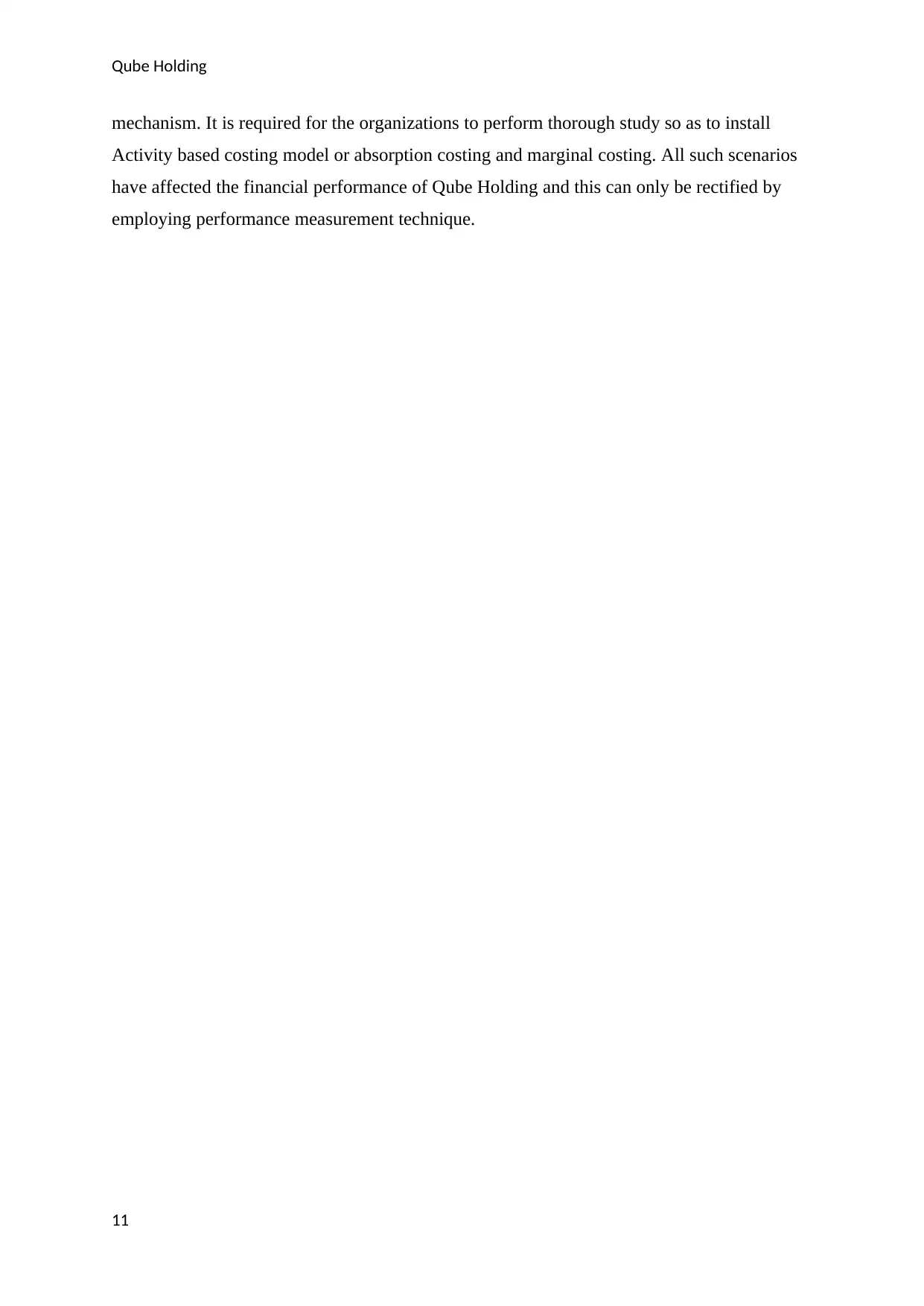
Qube Holding
mechanism. It is required for the organizations to perform thorough study so as to install
Activity based costing model or absorption costing and marginal costing. All such scenarios
have affected the financial performance of Qube Holding and this can only be rectified by
employing performance measurement technique.
11
mechanism. It is required for the organizations to perform thorough study so as to install
Activity based costing model or absorption costing and marginal costing. All such scenarios
have affected the financial performance of Qube Holding and this can only be rectified by
employing performance measurement technique.
11
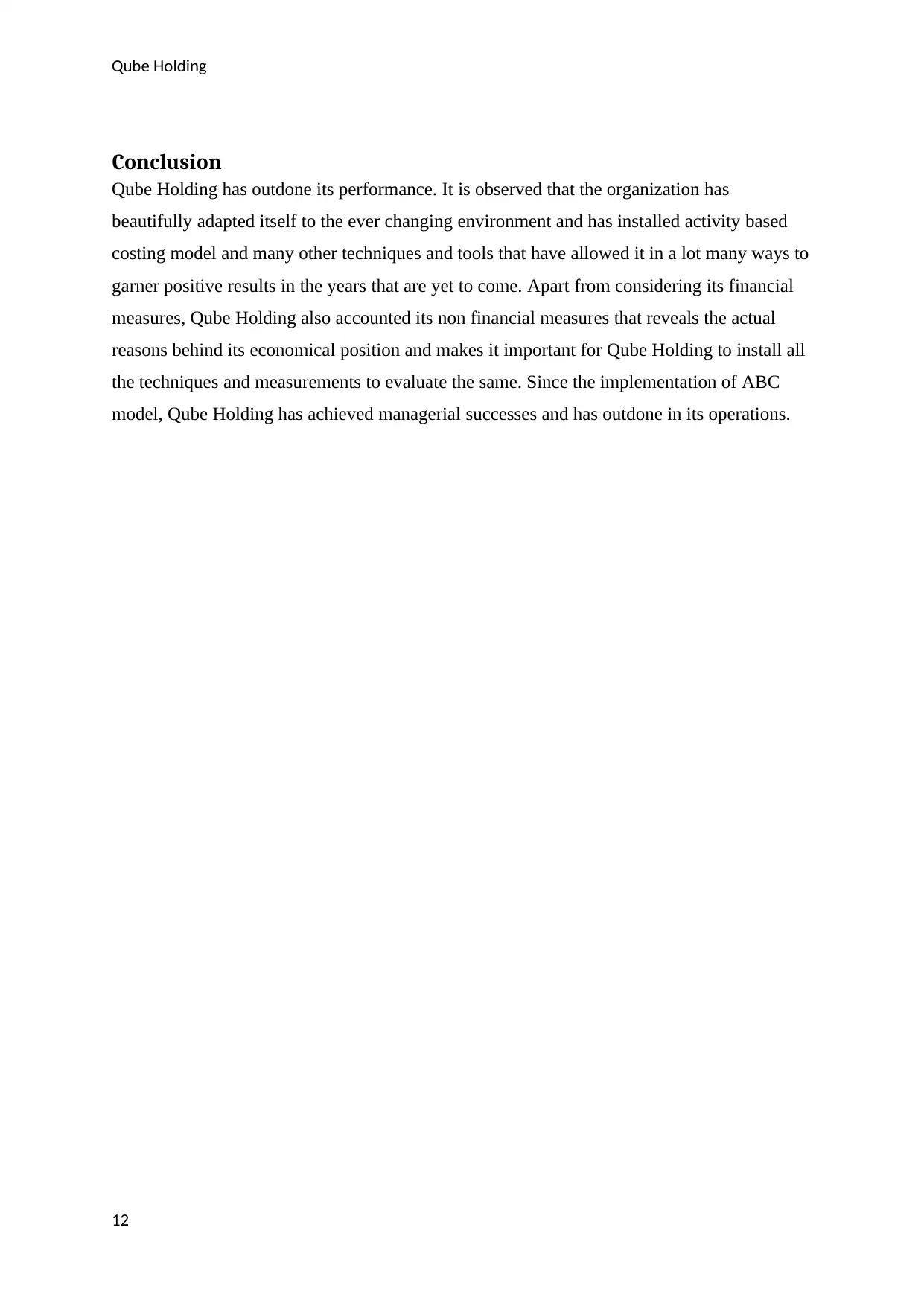
Qube Holding
Conclusion
Qube Holding has outdone its performance. It is observed that the organization has
beautifully adapted itself to the ever changing environment and has installed activity based
costing model and many other techniques and tools that have allowed it in a lot many ways to
garner positive results in the years that are yet to come. Apart from considering its financial
measures, Qube Holding also accounted its non financial measures that reveals the actual
reasons behind its economical position and makes it important for Qube Holding to install all
the techniques and measurements to evaluate the same. Since the implementation of ABC
model, Qube Holding has achieved managerial successes and has outdone in its operations.
12
Conclusion
Qube Holding has outdone its performance. It is observed that the organization has
beautifully adapted itself to the ever changing environment and has installed activity based
costing model and many other techniques and tools that have allowed it in a lot many ways to
garner positive results in the years that are yet to come. Apart from considering its financial
measures, Qube Holding also accounted its non financial measures that reveals the actual
reasons behind its economical position and makes it important for Qube Holding to install all
the techniques and measurements to evaluate the same. Since the implementation of ABC
model, Qube Holding has achieved managerial successes and has outdone in its operations.
12
⊘ This is a preview!⊘
Do you want full access?
Subscribe today to unlock all pages.

Trusted by 1+ million students worldwide
1 out of 13